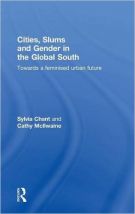Cities, Slums and Gender in the Global South: Towards a feminised urban future

Cities, Slums and Gender in the Global South explores the gendered nature of seven broad topics: land/housing, services, health, violence, mobility, productivity, and politics/governance. This analysis is founded on what the authors call the “gender–urban–slum interface”, a wide-ranging framework for understanding gender disparities at different urban scales and locations (with a detailed diagram on page 55).
Take gender-based violence, for example. This, according to the gender–urban–slum interface, is a cross-cutting issue for poor women in slums that reflects such key dimensions as gender disparities in power and rights, and such key criteria as household headship.
There are urban/rural variations in gender-based violence that justify a spatially differentiated approach. For example, compared to rural areas, cities tend to have higher reporting rates of violence against women, different types of social organization that could offer support to victims, and a different mix of domestic and non-domestic aggressors. Stretching this analysis to the level of slums, these spaces often have inadequate services and infrastructure, such as missing lights and poor policing, that compound women’s vulnerability to violence.
For each topic, Chant and McIlwaine describe the gendered nature of the issue, how this plays out in different urban spaces, and what measures organizations are adopting in response. For instance, to address violence against women, women’s desks have been instituted at Philippine police stations, and private–public partnerships have been formed to “adopt a light” in Nairobi slums. The authors’ analysis of violence and other gendered issues in cities leads them to recommend three overarching policy priorities, in the areas of unpaid work, quality of life and infrastructure; productivity; and equity in power and rights.
Chant and McIlwaine explain their rationale for approaching urban gender issues thus:
“While we clearly accept that women are not the only constituency to be disadvantaged in urban environments, we do feel that a gender agenda has to be in the front line of attempts to make cities more equitable. This is partly because we view the gap between women’s investments in building better cities in their everyday lives and the relative dearth of benefits they derive not only as an injustice in and of itself but also as a brake on the advances in gender equality which urbanisation could potentially help to generate.” (page 221)
Further reading:
Environment and Urbanization (2013), “Gender and urban change”, Vol 25, No 1, available at http://journals.sagepub.com/toc/eaua/25/1.
Thorbeck, Susuanne (1991), “Gender in two slum cultures”, Environment and Urbanization Vol 3, No 2, pages 71–81, available at http://journals.sagepub.com/doi/abs/10.1177/095624789100300211.
Whitzman, Carolyn, Caroline Andrew and Kalpana Viswanath (2014), “Partnerships for women’s safety in the city: “four legs for a good table””, Environment and Urbanization Vol 26, No 2, pages 443–456, available at http://journals.sagepub.com/doi/abs/10.1177/0956247814537580.
Book note prepared by Christine Ro
Search the Book notes database
Our Book notes database contains details and summaries of all the publications included in Book notes since 1993 - with details on how to obtain/download.
Use the search form above, or visit the Book notes landing page for more options and latest content.
For a searchable database for papers in Environment and Urbanization, go to http://eau.sagepub.com/

